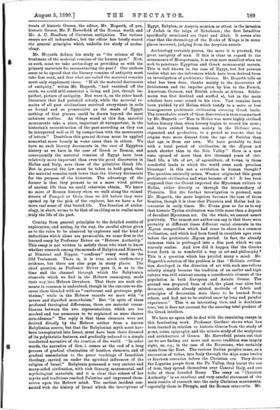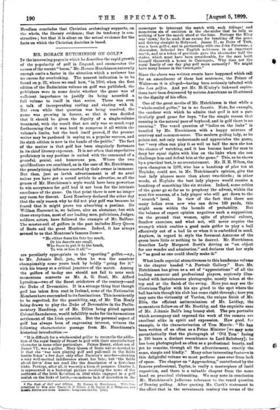THE VALUE OF ARCHEOLOGY.*
THERE are few facts more characteristic of our century than the remarkable discoveries in archmology. The farther removed we are from remote antiquity the more we know about it. This singular paradox has done much to renovate history,—so much, indeed, that we are perhaps tempted to exaggerate its effect on historical study. We have been accustomed to repeat some historical narrative taken from the literature of an ancient people. We discover some old monument making reference to the events in question. Evidently the new discovery renders the story more real and living, as we say, when we see the figure of the King or see the bas-relief of the procession. Bat is any narrative which is well authenticated in literature made any more certain by seeing it in stone? Or is the story in stone to be regarded as in any sense more authentic than that on parchment, handed down to us by succeeding generations of scholars from the original writers ? The present volume, which is at the same time learned and interesting, attempts to show exactly what are the benefits we have derived from arcbasology. The writers are various. Pro- fessor Driver deals with Hebrew civilisation and its asso- ciation with Oriental inscriptions. Mr. Francis LI. Griffith deals with Egypt and Assyria. Professor Ernest A. Gardner ° Authority and Archceoloyy : Sacred and Profane Essays on the Relation of Monuments to Biblical and Classical Literature. Edited by David G. liogartty Director of the British School at Athena Loudon : John Murray. [l68.]
treats of historic Greece, the editor, Mr. Hogarth, of pre. historic Greece, Mr. F. Haverfield of the Roman world, and Mr. A. C. Headlam of Christian antiquities. The various essays are all independent, but the editor has briefly stated the general principles which underlie the study of arches- ology.
Mr. Hogarth defines his study as " the science of the treatment of the material remains of the human past." Now, as such, must we take archaeology as providing us with the primary materials for reconstructing the past ? Our authors seem to be agreed that the literary remains of antiquity must take first rank, and that what are called the material remains must only supplement these. "If all the material documents of antiquity," writes Mr. Hogarth, "had vanished off the earth, we could still construct a living and just, though im- perfect, picture of antiquity. But were it, on the other band, literature that had perished utterly, while the material re- mains of all past civilisations survived everywhere in soils as fecund and as preservative as the sands of Egypt, nothing of that picture could be drawn beyond the moat nebulous outline. As things stand at this day, material monuments take a place, important Or unimportant, in the historian's reconstruction of the past according as they can be interpreted well or ill by comparison with the monuments of letters." Doubtless this general dictum must be applied somewhat more loosely in some cases than in others. We have no such literary documents in the case of Egyptian history as we have in the case of Greek or Roman, and consequently the material remains of Egypt have been relatively more important than even the great discoveries in Hellas and Italy, save those of the primitive Greek life. But in general the law must be taken to hold good, that the material remains rank lower than the literary documents for the purpose of the historian. The advantage of the former is that they present to us a more vivid picture of ancient life than we could otherwise obtain. We know no more of Roman history when we walk along the ruined streets of Pompeii or Ostia than we did before they were opened up by the pick of the explorer, but we have a far
more real sense of that buried life. The function of archae- ology, in short, seems to be that of enabling us to realise more truly the life of the past.
Coming from general principles to the detailed results of exploration, and noting, by the way, the careful advice given as to the rules to be observed by explorers and the kind of deductions which alone are permissible, we come first to the learned essay by Professor Driver on "Hebrew Authority." This essay is not written to satisfy those who want to know whether research among the mounds of Babylon and Nineveh, at Nimroud and Nippur, "confirms" every word in the Old Testament. There is, it is true, much confirmatory evidence, but there are also gaps in many places. The chief question, as Professor Driver puts it, is as to the time and the channel through which the Babylonian elements which we find in the Hebrew cosmogony, made their way into Hebrew literature. That there are such ele- ments in common is undoubted, though in the one case we dis- cover them blended with an " exuberant and grotesque poly- theism," while in the Hebrew records we meet with "a severe and dignified monotheism." But "in spite of these profound theological differences, there are material resem- blances betweeh the two representations, which are too marked and too numerous to be explained as mere chance coincidences." The reply is that these elements were not derived directly by the Hebrew author from a known Babylonian source, but that the Babylonian myth must have been transplanted into Israel, must have been there divested of its polytheistic features, and gradually reduced to a simple unadorned narrative of the creation of the world. 'In other words, the narrative of Gen. i. comes at the end of a long process of gradual elimination of heathen elements, and of gradual assimilation to the purer teachings of Israelitish theology, carried on under the spiritual influences of the religion of Israel." Babylonia possessed a very ancient and many-sided civilisation, with rich literary, monumental, and mythological materials, and it is clear that echoes of her myths and traditions reached Palestine and impressed them- selves upon the Hebrew mind. The earliest incident con- nected with the history of Israel which the inscriptions of Egypt, Babylon, or Assyria mention or attest is the invasion of Judah in the reign of Rehoboam ; the first Israelites specifically mentioned are Omri and Ahab. It seems also clear that the chronology of the Books of Kings is'in some places incorrect, judging from the Assyrian annals.
Archreology certainly proves, the more it is pursued, the great antiquity of man. If this is clear in regard to the monuments of Mesopotamia, it is even nore manifest when we seek to penetrate Egyptian and Greek monumental secrets. This is well known in the case of Egypt, but few persons realise what are the inferences which have been derived from an investigation of prehistoric Greece. Mr. Hogarth tells us what has been done, thanks mainly to the discoveries of Schliemann and the impulse given by him to the French, American, German, and British schools at Athens. Schlie- mann was first doubted and scoffed at, but in the main scholars have come round to his view. Vast remains have been yielded by all Hellas, which testify to a more or less homogeneous prehistoric civilisation coveting Greek lands. The remarkable result of these discoveries is thus summarised by Mr. Hogarth :—" Man in Hellas was more highly civilised before history than when history begins to record his state ; and there existed human society in the Hellenic area, organised and productive, to a period so remote, that its origins were more distant from the age of Pericles than that age is from our own. We have probably to deal with a total period of civilisation in the 2Egean not much shorter than in the Nile Valley." Here is a new vista opened of more than five thousand years of civi- lised life, a life of art, of agriculture, of towns, in those wonderful lands to which the world owes each priceless blessings ! Is this not a revolution in human thought ? The question naturally arises, Whence originated this great prehistoric civilisation and what became of it ? It has been supposed that the Orient imported the Mycenaean culture to Hellas, either directly or through the intermediary of Phoenicia. But the further investigation is pursued, says Mr. Hogarth, the more hopeless becomes the case of these Semites, though it is clear that Pbcenicia and Hellas had in- tercourse in early times. Mr. Evans goes so far as to say that historic Tyrian civilisation was little more than a deposit of decadent Mycenaean art. On the whole, we cannot assert positively. The utmost our author can say is that there were probably at different times different racial elements in the 2Egean composition which had come to share in a common civilisation, and which had been fused in countless ages even before the prehistoric AJgean period. In fact, the already immense vista is prolonged into a dim past which we can scarcely realise. And how did it happen that the Greeks burst forth in so wonderful a way in art and philosophy P This is a question which has puzzled many a mind. Mr. Hogarth's solution of the problem is that "Hellenic civilisa- tion developed in the direction of art with such marvellous celerity simply because the tradition of an earlier and high culture was still existent among a considerable element of the population in both European and Asiatic Greece. The ground was prepared from of old, the plant was alive but dormant, models already existed, methods of fabric and principles of decoration were there to be learned from others, and had not to be evolved anew by long and painful experience." This is an interesting view, and is doubtless true, but it does not account for the amazing total product of the Greek intellect.
We have no space left to deal with the remaining essays in this fascinating work. Professor Gardner shows what has been learned in relation to historic Greece from the study of gems, coins, epigraphy, and the minute study of the sculpture and architecture of Greece. Mr. Haverfield points out that (as we are finding out more and more) tradition was largely right, as, e.g., in the case of the Etruscane, who certainly came from the East. The various Italian peoples came, as a succession of tribes, into Italy through the Alps some twelve or fourteen centuries before the Christian era. They drove the Ligurian people from the Po Valley, they learnt the use of iron, they spread themselves over Central Italy, and one tribe of them founded Rome. The essay on "Christian Authority " is an excellent and very careful statement of the main results of research into the early Christian monuments, especially those in Phrygia, and the Roman catacotr be. Mr.
Headlam concludes that Christian archaeology supports, on the whole, the literary evidence; that its tendency is con- structive ; but that it is silent on the actual evidence for the facts on which the Christian doctrine is based.




































 Previous page
Previous page